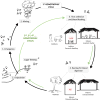Priorities for Broadening the Malaria Vector Control Tool Kit
- PMID: 28668377
- PMCID: PMC5623623
- DOI: 10.1016/j.pt.2017.06.003
Priorities for Broadening the Malaria Vector Control Tool Kit
Abstract
Long-lasting insecticidal nets (LLINs) and indoor residual spraying (IRS) have contributed substantially to reductions in the burden of malaria in the past 15 years. Building on this foundation, the goal is now to drive malaria towards elimination. Vector control remains central to this goal, but there are limitations to what is achievable with the current tools. Here we highlight how a broader appreciation of adult mosquito behavior is yielding a number of supplementary approaches to bolster the vector-control tool kit. We emphasize tools that offer new modes of control and could realistically contribute to operational control in the next 5 years. Promoting complementary tools that are close to field-ready is a priority for achieving the global malaria-control targets.
Keywords: Anopheles; behavior; insecticide resistance; integrated vector management; malaria; vector control.
Copyright © 2017 Elsevier Ltd. All rights reserved.
Figures


References
-
- World Health Organization. 370 978 92 4 156499 1Global technical strategy for malaria 2016–2030. 2015
Publication types
MeSH terms
Grants and funding
LinkOut - more resources
Full Text Sources
Other Literature Sources
Medical
Miscellaneous

